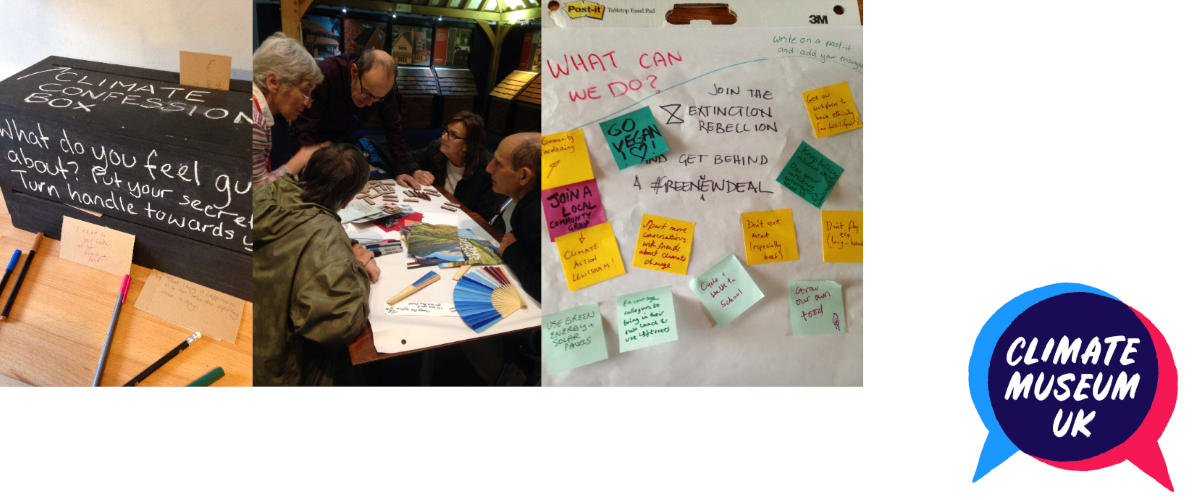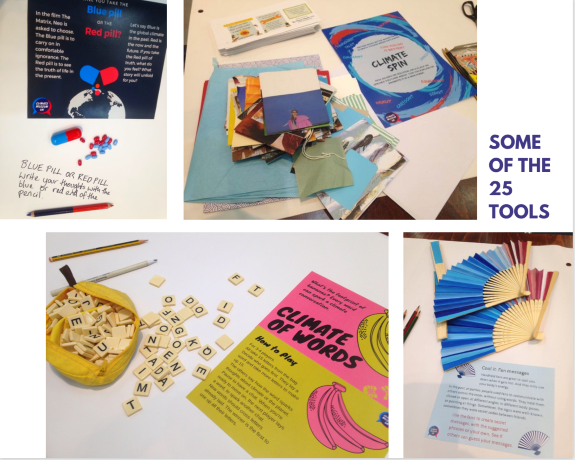“We exist to stir and collect creative responses to the emergency.”
The mobile and digital Climate Museum UK.
Bridget McKenzie in conversation with Elke Zobl and Timna Pachner
Who is on your team? Or are you working alone?
There are a number of other artists and creative communicators in the team as well. The idea is that we grow and grow. We want to create capacity and resources for artists all over the UK. We want artists, communicators and creative educators to create their own museum resources. Maybe they might create a mini museum in their house, in their school or in their studio using our principles. The idea is that they would donate one of their things to our central collection, but be out there, doing “Climate Museum activities”. When we pop up, we might have a selection of activities that suit the situation or the audience. We have a distinction between activities we do for the public and activities we do for professionals. We offer trainings for museum educators, teachers and cultural workers. Maybe, eventually, we might do workshops with psychologists or cultural therapy workers on how we help people to talk about the emergency and understand this big enormity. “How do we help people to make sense of it, to process their emotions and to take action?” So, at the moment, the demand is mostly in the area of training.
What was the point of departure to establish the museum? Was there an initial idea or spark?
Well, I have worked in museums, galleries and libraries for a long time. I suppose my first role was in 1985, so, that’s half my life. I was frustrated. I love museums but none of them would tackle the environmental emergency in a holistic way. Everything was a branch of science or natural history. I just felt there was a gap. I am aware that it is hugely challenging. I had been doing several projects in my consultancy company, Flow Associates; training, research and evaluation. All of those briefs and projects I was working on were bracketing out the climate emergency. About five years ago, I worked on a project called Future Views, which ran for about three years. Within this project, we should find out what young people feel about their creative futures. So we asked them: “How do you feel about your future as a creative?” The first thing they said was: “Well, I feel threatened by the politics and the lack of justice for us as young people. We are facing a future where we don’t know if we will be able to have children or even enough food in 20 years.” Of course, not every young person was saying that, but it was a big theme. We were running workshops across the country. We just had to take those responses and put them in a box. That frustrated me, and I decided that I had to stop working full time on those kinds of projects. Half my time, at least, I wanted to spend on enabling people to respond to the emergency and explore how they could work with it. The idea that it could be a museum popped up in my head two years ago, when I went to a conference about museums and climate change in Manchester that was set up by Henry McGhie. Actually, I had also been on a training course run by Julie’s Bicycle, which was a week-long creative climate leadership course. At the end of that course, we were asked to come up with some sort of an action plan. I decided to set up an organization which at the time I thought should be called Thrivable Culture. I was going to be running trainings and workshops. Back then, my idea was to focus on enabling people to create a regenerative culture. But it was too vague, and I realized that actually calling something a museum would get me places. Now, I am a museum director (laughs). It gives you more status than just saying: “I am running this training consultancy.” But we are a museum. We are collecting and playing with what a museum is.
When you focus on different aspects of climate change, what is important for you to communicate?
Well, I will just start by saying that we are resistant to communicating in the one-to-many-model. We are not doing science communication. We are not taking the best research and expertise to mediate it and make it accessible to the public. Our work is much more about enabling and it is more democratic. It is about everybody who comes into a room being seen as equal and having a quiet expertise. By coming together, people can communicate about the questions they have, the feelings they have, their action plan and the actions they want to take. By doing that, they discover. They develop a shared understanding of the emergency. I do have personal ideas that arise, and I do feel that I want to share them. But I try to keep those to my personal social media feed or my articles. Climate Museum UK is a platform for people to publish as well. I publish on it, but I want others to publish, too, so there are plural voices.
Bridget McKenzie,
Elke Zobl,
Timna Pachner
(
2021):
“We exist to stir and collect creative responses to the emergency.”.
The mobile and digital Climate Museum UK.
Bridget McKenzie in conversation with Elke Zobl and Timna Pachner. In: p/art/icipate – Kultur aktiv gestalten
#
12 ,
https://www.p-art-icipate.net/we-exist-to-stir-and-collect-creative-responses-to-the-emergency/



 Artikel drucken
Artikel drucken Literaturverzeichnis
Literaturverzeichnis